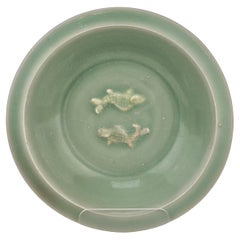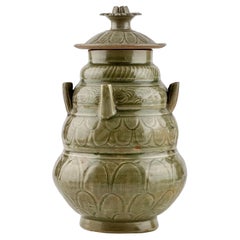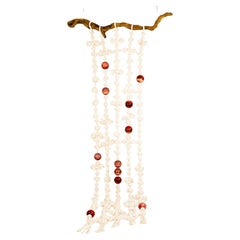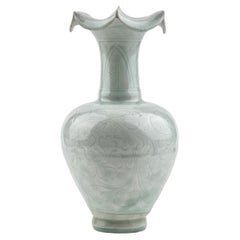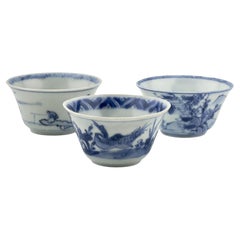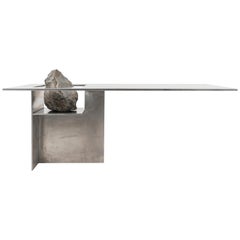South Korea - Furniture
to
262
508,059
445,269
318
233
18
111
7
1
293
20
5
251
315
115
74
64
62
565
440
252
163
125
569
357
418
50
11
8
7
7
Item Ships From: South Korea
Small Longquan Celadon 'Twin Fish' Dish, Southern Song Dynasty
Located in seoul, KR
The "twin fish" dishes, emblematic of fertility and marital joy, are also recognized as one of the Eight Buddhist symbols. These dishes were prominently produced by the Longquan kiln...
Category
15th Century and Earlier East Asian Antique South Korea - Furniture
Materials
Celadon
$3,244 Sale Price
34% Off
A Longquan Celadon Five-spouted Jar, Northern Song Dynasty (960~1127)
Located in seoul, KR
The jar features a round body with well-proportioned four distinct tiers and a short, stable foot. The surface is coated in a deep green Longquan celadon glaze, showcasing the sprout...
Category
15th Century and Earlier Hong Kong Antique South Korea - Furniture
Materials
Celadon
$6,175 Sale Price
35% Off
Bal. Hanging tapestry crafted from traditional Korean knots of cotton ropes
By WKND Lab
Located in Miami Beach, FL
Bal, by Wknd Lab
Color: Ivory, red
Size: 98.4 x 15.7 x 5.2 in.
Material: Cotton and Copper
Usage: Tapestry
Weight: 11 kg
Production time is 5 weeks.
Bal is a tapestry crafted from t...
Category
2010s North Korean Modern South Korea - Furniture
Materials
Copper
A Carved Qingbai 'Chrysanthemum' Vase, Song-Yuan Dynasty(13-14th century)
Located in seoul, KR
The ovoid body to a tall neck, the body decorated with a chrysanthemum meander, covered overall in a translucent pale blue glaze. Traces of excavation can be seen in the dirt marks o...
Category
15th Century and Earlier Hong Kong Antique South Korea - Furniture
Materials
Ceramic, Porcelain
$9,950 Sale Price
50% Off
Three Chinoiserie Teabowl Set Circa 1725, Qing Dynasty, Yongzheng Reign
Located in seoul, KR
The left artwork is a classic blue-and-white porcelain teacup, adorned with a delicate landscape scene. The exterior of the cup features intricate details of trees, houses, mountains...
Category
1720s Vietnamese Qing Antique South Korea - Furniture
Materials
Ceramic
$838 Sale Price / set
35% Off
Contemporary Block Form Stainless Steel Table with Natural Stone by Lee Sisan
Located in Geneve, CH
Proportions of stone table by Lee Sisan
2019
Dimensions: W 140 x D 60 x H 55 cm
Materials: Stainless steel, natural stone
Each piece is mad...
Category
2010s South Korean Modern South Korea - Furniture
Materials
Stone, Steel
Heritage Round Table by Lee Jung Hoon
Located in Geneve, CH
Heritage round table by Lee Jung Hoon
Dimensions: D 80 x W 70 x H 472.4 cm
Materials: Red oak, walnut, stainless steel, Corrosion
The Heritage series, created by designer Lee Ju...
Category
2010s Korean Post-Modern South Korea - Furniture
Materials
Stainless Steel
$9,874 / item
Carved Longquan Celadon Vase, Yuan-Ming Dynasty
Located in seoul, KR
A graceful baluster form with a flared mouth, a rounded body, and a slightly raised foot. The vase features two intricate handles in the shape of animal figures holding large looped ...
Category
15th Century and Earlier Hong Kong Ming Antique South Korea - Furniture
Materials
Celadon
$4,900 Sale Price
30% Off
Ginger Jar with 'Hehe Erxian' Pattern, Early Qing Dynasty(17-18th century)
Located in seoul, KR
The Hehe Erxian (和合二仙, Ho Ho Erh Hsien), Taoist immortals known for symbolizing harmony and union, are vividly depicted on this blue and white porcelain jar. Within the central medal...
Category
17th Century Hong Kong Qing Antique South Korea - Furniture
Materials
Ceramic, Porcelain
$1,925 Sale Price
30% Off
A Gray Pottery Figure of a Horse, Han Dynasty
Located in seoul, KR
This particular horse sculpture exemplifies the typical pose of Han-period equine figures—a neighing steed with its mouth wide open. Like many tomb sculptures of the era, it is crafted in unglazed, with its ears, tail, and legs separately fabricated in wood or clay and slotted into pre-prepared holes. However, several distinguishing features elevate this piece beyond standard Han horse...
Category
15th Century and Earlier Hong Kong Han Antique South Korea - Furniture
Materials
Earthenware, Pottery
$3,500 Sale Price
30% Off
Maeduep; Two Bees. Candle sconce / Backflow Incense
By WKND Lab
Located in Miami Beach, FL
Maeduep; Two Bees, 2023 by WKND Lab
From the series Tying Wishes
Cotton rope, brass
Color: Ivory, gold
Usage: Candle sconce / Backflow Incense Burner
Production time is 5 weeks.
A c...
Category
2010s North Korean Minimalist South Korea - Furniture
Materials
Metal, Brass
$1,550 / item
Rare Yue Celadon Chicken-Head Ewer, Jin-Southern Dynasty
Located in seoul, KR
Chicken-head ewers are among the most distinct and emblematic pottery pieces from the Han (206 BC ~ AD 220) to the Tang dynasties. Their production commenced during the Jin dynasty i...
Category
15th Century and Earlier Hong Kong Han Antique South Korea - Furniture
Materials
Pottery
$6,950 Sale Price
50% Off
Unique Box-Like Structure with Natural Stone, Stainless Stool by Lee Sisan
Located in Geneve, CH
Proportions of stone stool 02 by Lee Sisan, 2019
Dimensions: W 36 x D 36 x H 45 cm.
Materials: stainless steel, natural stone.
Each pie...
Category
2010s South Korean Modern South Korea - Furniture
Materials
Stone, Steel
Moulded Goldfish Blue and White Dishes, Ming Dynasty
Located in seoul, KR
Exquisitely decorated set of plates, dating back to around 1500, from the Hongzhi or Zhengde period. Intricately adorned with a raised, moulded goldfish design. The goldfish, painted in a orange-red enamel, are set amidst water plants depicted in rich cobalt blue.
These plates enjoyed widespread popularity, not only in the local markets of China but also overseas in countries. This style of plate played a significant role in the daily life of the Sengoku period in Japan, as evidenced by several similar flat bowls excavated from the Ichijodani Asakura Ruins in Fukui Prefecture, Japan, along with other ceramic artifacts...
Category
16th Century Indonesian Ming Antique South Korea - Furniture
Materials
Ceramic
$1,950 Sale Price / set
50% Off
Beomjong. Wall light
By WKND Lab
Located in Miami Beach, FL
Beomjong lighting, by Wknd Lab
Color: Ivory, gold
Size: 140 x 780 x 300 (mm)
Material: Steel, chilbo (glass enamel)
Usage: Lighting
Weight: 6 kg
Production time is 5 weeks.
Beomjong light is inspired by a traditional Korean bell...
Category
2010s North Korean Modern South Korea - Furniture
Materials
Aluminum, Copper
$4,300 / item
Brown-Glazed Moulded Box And Cover, Fujian Kiln, Yuan-Ming Dynasty
Located in seoul, KR
The circular domed cover moulded with a brown glaze that falls short of the straight foot. The pattern on the left features a central circular design with simple shapes and lines car...
Category
15th Century and Earlier Chinese Ming Antique South Korea - Furniture
Materials
Pottery
$2,100 Sale Price / set
30% Off
Ming Period Large Pottery Horse with Saddle (15-16th Century)
Located in seoul, KR
The figure stands on a rectangular base. The horse is depicted in a poised stance, with strong, muscular legs and a slightly bowed head. The mane is carefully sculpted with deep, flowing grooves, adding a dynamic texture to the piece. The head features expressive details, including a well-defined muzzle, flared nostrils. The bridle and harness are delicately painted in faded green, contrasting against the creamy beige body. The saddle is adorned with intricate details, including decorative tassels and a textured pattern, indicative of the elaborate tack used in the Ming period.
Traces of original polychrome pigments in green, black, and ochre remain on the surface, hinting at the sculpture’s once-vibrant appearance. The weathered patina and areas of flaking paint add to its historical authenticity, reflecting centuries of age. The overall craftsmanship and detailing exemplify the Ming Dynasty’s refined ceramic artistry, making this piece a remarkable representation of of asian culture during this period.
Period: Ming Dynasty
Medium: Green, black, and ochre glazed Pottery
Type: Figure
Condition : Good(chips on the upper saddle.)
Provenance : Acquired in late 1990s from Hongkong
Reference : Asian Civilisations Museum - Accession No. C-1384 / 1994-00441 - Ming Dynasty Figure of Horse
(Type : Closely Related)
* Ming Dynasty Glazed Pottery Figures
Ming Dynasty glazed pottery figures are renowned for their bold color palette, intricate detailing, and lifelike forms, distinguishing them from earlier traditions. These figures, which depict officials, warriors, animals, and mythical creatures, are characterized by high-gloss lead-based glazes in green, amber, ochre, and sancai (three-color) combinations. The thickly applied glaze pools in recesses, creating depth and enhancing sculptural details. With dynamic postures, expressive facial features, and meticulously rendered drapery, these figures reflect the period’s advancement in ceramic craftsmanship, offering a greater sense of movement and realism compared to the rigid and stylized forms of earlier dynasties.
A defining characteristic of Ming glazed pottery is its elaborate surface detailing, often achieved through raised relief elements and contrasting glazes. Equestrian figures, for example, feature carefully sculpted saddles, harnesses, and decorative embellishments, while human figures are adorned with intricate robes and headdresses. The large scale of these tomb figures, often more imposing than those from previous periods, underscores the increasing importance of funerary art during the Ming era. Unlike later Qing Dynasty figures...
Category
15th Century and Earlier Hong Kong Ming Antique South Korea - Furniture
Materials
Pottery
$2,800 Sale Price
30% Off
Rare Annamese Stoneware Bowls with Brown-Green Glaze, Vietnam, 14th–15th Century
Located in seoul, KR
This finely matched pair of Annamese stoneware bowls exemplifies the refined ceramic artistry of Đại Việt (medieval Vietnam) during the 14th to 15th century. Each bowl is delicately ...
Category
15th Century and Earlier Vietnamese Antique South Korea - Furniture
Materials
Stoneware
$1,596 Sale Price / set
30% Off
Pair of Rider Figures on Mythical Beasts Possibly from Qing Dynasty
Located in seoul, KR
Identical piece is housed in the Longhai Museum of Zhangzhou City. On October 7, 1989, it was appraised as a third-class cultural relic by the Cultural Relics Appraisal Team of the F...
Category
17th Century Hong Kong Qing Antique South Korea - Furniture
Materials
Pottery
$2,275 Sale Price / set
35% Off
Copper Red Brushpot, Qing Dynasty, Kangxi Mark
Located in seoul, KR
This porcelain brush pot, crafted on a white body, is delicately decorated with copper red (hongcai 紅彩), depicting a figure in traditional attire amidst a landscape of pine trees, ro...
Category
Early 18th Century East Asian Qing Antique South Korea - Furniture
Materials
Copper
$1,800 Sale Price
40% Off
Jjirasi Vase #04. From the series Jjirasi
By Yongwon Noh
Located in Miami Beach, FL
Jjirasi Vase #04, 2021 by Yongwon Noh
From the series Jjirasi
Ceramic, PVC Sticker and Resin
Size: 6.6 in. H x 5.5 in. W x 5.5 in. D
Weight: 3kg Unpacked
Unique Piece
Signature writ...
Category
2010s North Korean Modern South Korea - Furniture
Materials
Ceramic, Resin, PVC
Lotus Petal 'Longquan' Celadon Bowl, Ming dynasty
Located in seoul, KR
The bowl features a relatively deep green glaze and a smooth and lustrous finish. The exterior is intricately incised with a lotus petal design, symbolizing purity and spiritual enlightenment, while the interior remains plain to emphasize the glaze's elegance. Over centuries, a natural brown discoloration has appeared on the exterior, reflecting its historical authenticity and prolonged chemical reaction during burial. This is also considered a part of the aesthetic element of celadon.
Period: Ming Dynasty (1368~1644)
Region: Longquan, China
Medium: Stoneware - Celadon glazed
Type: Tripod censer
Size : 18.5 cm(Diameter) , 7.5cm(Height)
Provenance : Acquired in late 1990s from Hongkong
* Ming Dynasty Longquan Celadon
Longquan celadon from the Ming Dynasty typically exhibits a more robust and heavier stoneware body compared to its Song Dynasty predecessors. The Ming era saw an evolution in celadon glaze, achieving a wider spectrum of green hues, from olive to bluish-greens. Ming celadons...
Category
15th Century and Earlier Hong Kong Ming Antique South Korea - Furniture
Materials
Celadon
$4,194 Sale Price
40% Off
15 Auspicious Korean Traditional Embroidered Pillows
Located in seoul, KR
15 traditional embroidered pillows usually given by a bride to her husband as part of her dowry during marriage in Korea's modern era. These embroideries feature traditional symbols ...
Category
19th Century Korean Antique South Korea - Furniture
Materials
Fabric
$2,080 Sale Price / set
35% Off
Blue and White Porcelain Longevity Dish, Qing Period (18-19th century)
Located in seoul, KR
The dish features underglaze cobalt blue decoration, showcasing the Chinese character "shou" (symbolizing long life) at the center. Surrounding the center are bands with a stylized S...
Category
Early 19th Century East Asian Qing Antique South Korea - Furniture
Materials
Ceramic, Porcelain
Celadon Bowl with Incised Lotus Patterns, Song Dynasty
Located in seoul, KR
Beneath the soft grayish-green glaze, incised lotus design emerges. The surface is adorned with flowing lines depicting lotus flowers and leaves, rendered in a refined carving techni...
Category
15th Century and Earlier East Asian Antique South Korea - Furniture
Materials
Celadon
$1,050 Sale Price
30% Off
Two blue and white jars, officials in garden, Rabbit mark to base, Ming dynasty
Located in seoul, KR
17th century, painted in underglaze blue with eight figures including officials in a garden landscape, marked on the bottom with a sitting rabbit(blue hare), Transitional period(Late...
Category
17th Century Hong Kong Ming Antique South Korea - Furniture
Materials
Ceramic, Porcelain
$3,594 Sale Price / set
40% Off
A Longquan Celadon-Glazed 'Dragon' Dish, Yuan Dynasty
Located in seoul, KR
The dish is decorated to the centre with a moulded appliqué dragon chasing the flaming pearl surrounded by a carved stylised foliage band at the cavetto. The moulded fluted exterior ...
Category
15th Century and Earlier Hong Kong Ming Antique South Korea - Furniture
Materials
Celadon
$5,925 Sale Price
25% Off
JASOO. Stool
By WKND Lab
Located in Miami Beach, FL
JASOO. (Stool), 2022 by Wknd Lab
From the series When Tiger Used to Smoke..
Fabric, silk, black
Measurements: 30 x Ø 42 cm
Heritage: Korea
Unique piece
Production time is 5 weeks.
Stool inspired by an old Korean phrase “When the tiger used to smoke” meaning “once upon a time”, and humor from folk paintings of bunnies holding the pipe for the tiger in horror. Jasoo – Korean embroidery is one of the representative oriental embroidery and has all the general characteristics of oriental...
Category
2010s North Korean Modern South Korea - Furniture
Materials
Fabric, Textile, Silk
$11,700
Five Green Glazed Pottery Attendant Figures, Ming Dynasty(1368-1644)
Located in seoul, KR
The three figurines in the back exhibit the typical form of attendants, wearing conical red hats and adopting poses where their right hands are either held in front of their chests o...
Category
15th Century and Earlier Hong Kong Ming Antique South Korea - Furniture
Materials
Pottery
$2,925 Sale Price / set
35% Off
Amber Rose Sunset Gradient Crystal Contemporary Dining Table 12 by Saerom Yoon
Located in Geneve, CH
Table 12 by Saerom Yoon
Dimensions: Ø 120 x H 75 cm.
Materials: Acrylic.
My oldest childhood memories go back to the time I spent in the Philippines with my ...
Category
2010s Korean Modern South Korea - Furniture
Materials
Acrylic
Rare Longquan Celadon Tripod Incense Burner, Song-Yuan Dynasty
Located in seoul, KR
The vessel features a compressed body supported by three tapered feet and a flat, outwardly flaring rim. Three slender flanges originate from a subtle ridge on the shoulder and exten...
Category
15th Century and Earlier Hong Kong Antique South Korea - Furniture
Materials
Celadon
$17,500 Sale Price
50% Off
Unique Z Letter Shape, Stainless Steel Stool with Natural Stones by Lee Sisan
Located in Geneve, CH
Proportions of stone stool 05 by Lee Sisan, 2020
Dimensions: W 36 x D 36 x H 45 cm.
Materials: Stainless steel, natural stone.
Each piece is made to order a...
Category
2010s South Korean Modern South Korea - Furniture
Materials
Stone, Steel
Two Figures of Attendants, Ming Period(1368-1644)
Located in seoul, KR
Statues of attendants crafted from terracotta, featuring glazes in green, Set on rectangular bases.
Period: Ming Dynasty
Medium: Glazed Pottery
Type: Figure
Condition : Excellent(It has soil on it, which is presumed to be evidence of excavation)
Provenance : Acquired in late 1990s from Hongkong
Reference :
1) Indianapolis Museum of Art - Dinastia ming, figure maschili, 1368-1644
(Type : Closely related)
2) V&A Museum - Accession number FE.295:1, 2-2005
(Type : Closely related)
3) Sotheby's 01 May 2007 - The Collection Of Paul Otto Taubert & Jewellery And Decorative Arts - Lot 233
(Price range : 5,000 - 7,000 AUD / Type : Closely related)
4) Asian Art Museum, San Francisco - Object number B60P1631 - Standing Man Tomb Figure
* Ming Dynasty Glazed Pottery Figures
Ming Dynasty glazed pottery figures are renowned for their bold color palette, intricate detailing, and lifelike forms, distinguishing them from earlier traditions. These figures, which depict officials, warriors, animals, and mythical creatures, are characterized by high-gloss lead-based glazes in green, amber, ochre, and sancai (three-color) combinations. The thickly applied glaze pools in recesses, creating depth and enhancing sculptural details. With dynamic postures, expressive facial features, and meticulously rendered drapery, these figures reflect the period’s advancement in ceramic craftsmanship, offering a greater sense of movement and realism compared to the rigid and stylized forms of earlier dynasties.
A defining characteristic of Ming glazed pottery is its elaborate surface detailing, often achieved through raised relief elements and contrasting glazes. Equestrian figures, for example, feature carefully sculpted saddles, harnesses, and decorative embellishments, while human figures are adorned with intricate robes and headdresses. The large scale of these tomb figures, often more imposing than those from previous periods, underscores the increasing importance of funerary art during the Ming era. Unlike later Qing Dynasty figures...
Category
15th Century and Earlier Hong Kong Ming Antique South Korea - Furniture
Materials
Pottery
$1,820 Sale Price
35% Off
Qingbai Floriform Dish, Song-Yuan Dynasty
Located in seoul, KR
The dish has a scalloped rim, which gives it a flower-like appearance. The wavy edges are characteristic of the Song dynasty ceramics, often inspired by natural forms such as flowers...
Category
15th Century and Earlier Hong Kong Antique South Korea - Furniture
Materials
Ceramic
$2,686 Sale Price
55% Off
Changsha Bowl from Belitung Ship, Tang Period
Located in seoul, KR
The edges have been dipped in four places with brown, probably iron-oxide. The well of the bowl is freely painted in deep green and coffee coloured brown. These are characteristic fe...
Category
15th Century and Earlier Indonesian Tang Antique South Korea - Furniture
Materials
Pottery
$1,625 Sale Price
35% Off
Pottery Tripod Vessel, Neolithic Period
Located in seoul, KR
The sturdy triangular legs, wide mouth, convex body, and diagonal incised patterns create a harmonious balance, showcasing a form that is both primitive and refined. Notably, the twi...
Category
15th Century and Earlier Hong Kong Antique South Korea - Furniture
Materials
Earthenware, Pottery
$1,400 Sale Price
30% Off
Annamese stoneware with underglaze blue, Hoi An hoard, late 15th century
Located in seoul, KR
At the center, within a shield-shaped frame, a delicate plant motif with slender stems and leaves is depicted, symbolizing the vitality of nature through simple lines. The shield-shaped frame harmonizes with the vase's curves, emphasizing the plant design. The neck features elongated leaf patterns, while soft cloud motifs are gracefully arranged along the body, following the vase’s natural flow. At the base, repetitive geometric patterns provide a sense of stability. This vase beautifully captures classical and serene beauty through the balance of natural harmony and meticulous craftsmanship.
Dates : 15th century Le Dynasty
Region : North Annam, Vietnam
Type : Yuhuchun Vase
Found/Acquired : Southeast Asia , South China Sea, Hoi An Ship
Reference :
1) Art Gallery of Greater Victoria - A vase from the wreck of the Hoi An
2) Butterfield Treasures Hoi An Hoard...
Category
15th Century and Earlier Vietnamese Antique South Korea - Furniture
Materials
Stoneware
Covered Boxes from Ca Mau Ship, Qing Dynasty, Yongzheng Reign
Located in seoul, KR
The central design features botanical motifs, with fully bloomed flowers and branches intricately depicted. The rim of the lid is encircled by a decorative band resembling a twisted ...
Category
18th Century Vietnamese Qing Antique South Korea - Furniture
Materials
Ceramic
$1,625 Sale Price / set
35% Off
A Large Carved Longquan Celadon Yuhuchunping, Yuan-Ming Dynasty
Located in seoul, KR
The bulbous body is adorned with elegantly carved floral motifs, with intertwining vines and flowers forming a natural, flowing pattern. The base is left unglazed. Base surface crack...
Category
15th Century and Earlier Indonesian Ming Antique South Korea - Furniture
Materials
Celadon
$9,750 Sale Price
35% Off
Four Green Glazed Pottery Attendant Figures, Ming Dynasty(1368-1644)
Located in seoul, KR
The first figure wears a short cap and takes a posture as if carrying something on the shoulder, possibly symbolizing a servant or a messenger.
The second figure wears a tall hat and...
Category
15th Century and Earlier Hong Kong Ming Antique South Korea - Furniture
Materials
Pottery
$1,950 Sale Price
35% Off
Seo of 4 Eggshell Vases. From the Oygg series
By WKND Lab
Located in Miami Beach, FL
Seo of 4 Eggshell Vases, 2023
From The Oygg series
Material : Egg Shells, Jesmonite
Dimensions: 41.2 W x 10 D x 19.3 H (cm)
Individual size: 10.3 W x 10 D x 19.3 H (cm)
Weight: 5 kg...
Category
2010s North Korean Modern South Korea - Furniture
Materials
Shell, Eggshell
Set of 3 Trays. From The Tempera series
By WKND Lab
Located in Miami Beach, FL
Set of 3 Trays, 2023
From The Tempera series
Material: Duck egg yolk, binder
Overall size: 19.5 Diameter x 15 H (cm)
Individual Dimensions: 19.5 Diameter x 5 H (cm)
Weight: avg. 1kg
Every piece is hand-made, color and measurement may slightly vary.
Colors: Black and Ivory
Production time is 5 weeks.
Tempera series Candle Holder...
Category
2010s North Korean Modern South Korea - Furniture
Materials
Shell
$360 / set
Blue Black Mother-of-Pearl Wooden Object Vase 02
By Arijian, Jian Yoo
Located in Namyangju-si, KR
Decorative handcrafted vase with mother-of-pearl inlay.
Category
2010s South Korean South Korea - Furniture
Materials
Wood
Wall Decor Handcrafted Painting on Wood Panel by Arijian Rose 03
Located in Namyangju-si, KR
The rose, forever a symbol of romantic love is expressed multifariously by using mother of pearl, lacquer, gilt, and silver powder in this work. It delivers the delicate touches of a...
Category
2010s South Korean South Korea - Furniture
Materials
Wood
Amber Blush Sunset Gradient Crystal Round Contemporary Table 11 by Saerom Yoon
Located in Geneve, CH
Table 11 by Saerom Yoon
Dimensions: Ø 90 x H 70 cm.
Materials: Acrylic.
My oldest childhood memories go back to the time I spent in the Philippines with my parents. The green mounta...
Category
2010s Korean Modern South Korea - Furniture
Materials
Acrylic
Cizhou Lotus Carved Jar, Song-Yuan dynasty
Located in seoul, KR
This jar features a carved design, which is typical of Cizhou ware. It has a creamy white and brown color scheme, and the prominent decoration of lotus flower, which is a common motif in Chinese art and culture, symbolizing purity and enlightenment.
The carving technique involves coating the vessel with a layer of white slip (liquid clay), then carving away parts of it to create the design, revealing the darker clay body beneath. This technique allows for a strong contrast between the background and the carved motif.
Period : Song-Yuan Dynasty
Type : Jar
Medium : Cizhou Ware
Size : 21.5 cm(Height), 11cm(Mouth Diameter)
Provenance : Acquired in 1999, Hongkong
* Cizhou Ware
Cizhou is the name given to a number of stonewares, grey or buff, of varying degrees of hardness, with painted, incised or carved decoration on a clay slip. These stonewares were not only made in the region of Cizhou, Hebei Province, but in several provinces of China during the Song, Yuan and Ming periods. The great centres of production were in the north of China in the provinces of Hebei, Henan and Shanxi.
Cizhou wares seem to have been very popular, made for a clientèle of rich merchants, at a period when the paintings of famous...
Category
15th Century and Earlier Hong Kong Antique South Korea - Furniture
Materials
Pottery
$3,835 Sale Price
35% Off
Famille rose porcelain vase, 19-20th century
Located in seoul, KR
This porcelain vase, likely from the late Qing dynasty or early Republic period (late 19th to early 20th century), is a fine example of Famille-Rose (fencai) decoration. The body is ...
Category
Late 19th Century Hong Kong Qing Antique South Korea - Furniture
Materials
Ceramic, Porcelain
$1,400 Sale Price
30% Off
Blue and White Bowl Circa 1725, Qing Dynasty, Yongzheng Era
Located in seoul, KR
Bowl decorated with beautiful floral and bird pattern. Cracks on surface due to underwater excavation condition. Relatively rare piece among Ca Mau ship pieces.
Period : Qing Dynast...
Category
1720s Vietnamese Qing Antique South Korea - Furniture
Materials
Ceramic, Porcelain
$513 Sale Price
35% Off
Ming Period Large Pottery Horse with Saddle (15-16th Century)
Located in seoul, KR
This Ming Dynasty painted pottery horse is depicted standing on a tiered rectangular pedestal. The horse has a well-proportioned body, with sturdy legs and a slightly arched neck. The eyes and muzzle are subtly outlined and incised.
The mane is sculpted with deep, parallel grooves. The tail is long and slightly curved left, extending downward. The saddle is prominently featured at the center of the horse’s back, detailed with a raised, rounded seat and an attached stirrup hanging down one side. The saddlecloth is textured with a crosshatch pattern, bordered by a row of carved fringe-like elements. The horse's legs display subtle musculature, and the hooves are clearly defined, with black pigment accentuating their edges.
The original painted pigments, including white, black, and ochre, are still visible, though faded in some areas. The black pigment highlights the mane, tail, and parts of the bridle, while the ochre tones accentuate the saddle and decorative elements.
Period: Ming Dynasty
Medium: Green, black, and ochre glazed Pottery
Type: Figure
Provenance : Acquired in late 1990s from Hongkong
Reference : Asian Civilisations Museum - Accession No. C-1384 / 1994-00441 - Ming Dynasty Figure of Horse
(Type : Closely Related)
* Ming Dynasty Glazed Pottery Figures
Ming Dynasty glazed pottery figures are renowned for their bold color palette, intricate detailing, and lifelike forms, distinguishing them from earlier traditions. These figures, which depict officials, warriors, animals, and mythical creatures, are characterized by high-gloss lead-based glazes in green, amber, ochre, and sancai (three-color) combinations. The thickly applied glaze pools in recesses, creating depth and enhancing sculptural details. With dynamic postures, expressive facial features, and meticulously rendered drapery, these figures reflect the period’s advancement in ceramic craftsmanship, offering a greater sense of movement and realism compared to the rigid and stylized forms of earlier dynasties.
A defining characteristic of Ming glazed pottery is its elaborate surface detailing, often achieved through raised relief elements and contrasting glazes. Equestrian figures, for example, feature carefully sculpted saddles, harnesses, and decorative embellishments, while human figures are adorned with intricate robes and headdresses. The large scale of these tomb figures, often more imposing than those from previous periods, underscores the increasing importance of funerary art during the Ming era. Unlike later Qing Dynasty figures...
Category
15th Century and Earlier Hong Kong Ming Antique South Korea - Furniture
Materials
Pottery
$2,600 Sale Price
35% Off
Cizhou Baluster Jar, Yuan-Ming Dynasty
Located in seoul, KR
The vase features a broad, rounded body with a slightly flared neck and a pedestal base. The decoration consists of intricate brushwork in iron-brown pigment, depicting figures and s...
Category
15th Century and Earlier Hong Kong Antique South Korea - Furniture
Materials
Pottery
$2,995 Sale Price
24% Off
Three Annamese Small Jars with bird design, 15th century, Le Dynasty
Located in seoul, KR
Vietnamese stoneware jar with representative bird designs. These pieces exhibit a relatively vivid and clear color compared to similar works from Hoi An hoard. The main feature of th...
Category
15th Century and Earlier Vietnamese Antique South Korea - Furniture
Materials
Stoneware
$1,813 Sale Price
30% Off
Wall Decor Landscape Painting on Wood Panel by Arijian
By Arijian
Located in Namyangju-si, KR
Landscape Painting with Mother-of-Pearl inlay by Arijian.
Category
2010s South Korean South Korea - Furniture
Materials
Wood
Grey Tripod Granary Jar, Han dynasty
Located in seoul, KR
The vessel consists of a rounded cylindrical body, a gently curved upper section, and a small circular opening, suggesting that it was used for storing grain or valuable goods.
Thre...
Category
15th Century and Earlier Hong Kong Han Antique South Korea - Furniture
Materials
Earthenware
$1,300 Sale Price
35% Off
Neolithic Pottery Jar, Majiayao culture, 3rd-2nd Millenium BC
Located in seoul, KR
Fine-grained, buff-colored clay. Potted thin. Upper part of body painted with symbolic patterns in black and chocolate brown. Majiayao culture, Banshan type, 3rd millennium BC
Peri...
Category
15th Century and Earlier Hong Kong Antique South Korea - Furniture
Materials
Earthenware, Pottery
$2,470 Sale Price
35% Off
Blue and White Baluster Vase, Qing Dynasty, Kangxi Era, Circa 1690
Located in seoul, KR
Spirally moulded and painted with bands of overlapping petal panels of figured riverscapes
Period : Qing Dynasty, Kangxi Period
Production Date : 1690-1699
Made in : Jingdezhen
Destination : Netherland
Found/Acquired : Southeast Asia , South China Sea, Vung Tau...
Category
1690s Vietnamese Chinoiserie Antique South Korea - Furniture
Materials
Ceramic
$2,593 Sale Price
35% Off
Ancient Gu Shape 'Canal Houses' Vase, Qing Dynasty, Kangxi Era, Circa 1690
Located in seoul, KR
This vase is decorated with dutch canal houses on one side and Chinese pagodas and flowers on the other side. Eastern and Western motifs were simultaneously expressed in ceramics.
Period : Qing Dynasty, Kangxi Period
Production Date : 1690-1699
Made in : Jingdezhen
Destination : Netherland
Found/Acquired : Southeast Asia , South China Sea, Vung Tau...
Category
1690s Vietnamese Chinoiserie Antique South Korea - Furniture
Materials
Ceramic
$3,893 Sale Price
35% Off
A Molded Qingbai 'Flowers' Dish, Southern Song Dynasty
Located in seoul, KR
The plate depicted here exhibits the intricate floral patterns and lotus motifs that are typical of Southern Song designs. The central floral motif captures the essence of Oriental b...
Category
15th Century and Earlier Hong Kong Antique South Korea - Furniture
Materials
Ceramic
$1,560 Sale Price
60% Off
Large Cocoon-shaped jar with cloud-scroll design, Han Dynasty
Located in seoul, KR
This jar would have served as a mortuary object (mingqi), placed in a tomb as a substitute for the more valuable bronze and lacquer vessels used in daily life. Along with a variety o...
Category
15th Century and Earlier Hong Kong Han Antique South Korea - Furniture
Materials
Pottery
$1,813 Sale Price
30% Off
Layered Steel Seat XVI by Hyungshin Hwang
Located in Geneve, CH
Layered steel seat XVI by Hyungshin Hwang.
Dimensions: D 33 x W 54 x H 54 cm.
Materials: stainless steel.
Layered Series is the main theme and concept of work of Hwang, who cont...
Category
2010s Korean Post-Modern South Korea - Furniture
Materials
Stainless Steel
$4,937 / item
Blue Sandy Gradient Sunset Crystal Contemporary Dining Table 07 by Saerom Yoon
Located in Geneve, CH
Table 07 by Saerom Yoon
Dimensions: D 70 x W 180 x H 80 cm.
Materials: Acrylic.
My oldest childhood memories go back to the time I spent in the Philippines with my parents. The gree...
Category
2010s Korean Modern South Korea - Furniture
Materials
Acrylic
